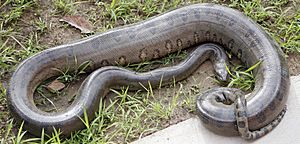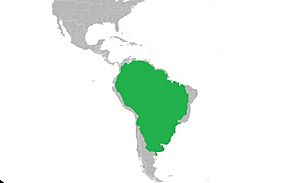Anaconda facts for kids
Quick facts for kids AnacondaTemporal range: Miocene-recent
|
|
|---|---|
 |
|
| Green anaconda, Eunectes murinus | |
| Scientific classification |
|
| Kingdom: | Animalia |
| Phylum: | Chordata |
| Class: | Reptilia |
| Order: | Squamata |
| Suborder: | Serpentes |
| Family: | Boidae |
| Subfamily: | Boinae |
| Genus: | Eunectes Wagler, 1830 |
 |
|
| Range of Eunectes | |
| Synonyms | |
|
|
Anacondas are a group of very large snakes found in tropical South America. They are also known as water boas because they spend a lot of time in water. There are currently four types, or species, of anacondas known.
Contents
About Anacondas
When people talk about "the anaconda," they usually mean the green anaconda (Eunectes murinus). This snake is the heaviest in the world. It is also the second longest, after the reticulated python.
Anacondas are known for being very strong. They are constrictors, meaning they wrap around their prey and squeeze it. This helps them catch and eat large animals.
Where the Name Comes From
The word "anaconda" might have come from a snake in Sri Lanka, an island country. Some people think it came from a Tamil word, anai-kondra, which means "elephant killer." This sounds very powerful!
In Brazil, people often call anacondas sucuri, sucuriju, or sucuriuba.
Types of Anacondas and Other Uses of the Word
The word "anaconda" usually refers to any snake in the Eunectes group. These are large, water-loving snakes from South America.
Here are the four main types:
- Eunectes murinus, the green anaconda: This is the biggest species. You can find it in countries like Colombia, Venezuela, Brazil, and Ecuador.
- Eunectes notaeus, the yellow anaconda: This is a smaller type. It lives in places like Bolivia, Paraguay, and Argentina.
- Eunectes deschauenseei, the darkly-spotted anaconda: This species is quite rare. It is found in northeastern Brazil and French Guiana.
- Eunectes beniensis, the Bolivian anaconda: This is the newest species discovered. It lives in the Beni and Pando areas of Bolivia.
Sometimes, the word "anaconda" is used in other ways too. It can be a metaphor, which means using it to describe something else. For example:
- The Anaconda Plan was a strategy used during the American Civil War. The idea was to "squeeze" or "suffocate" the opposing army, just like an anaconda squeezes its prey.
- In Brazilian jiu-jitsu, there is a move called the anaconda choke. It is a way to hold an opponent that makes it hard for them to breathe. If you get caught in this move, you have to tap out, or you might pass out!
Images for kids
-
Skeleton at the Redpath Museum
-
A 4.3-metre (14 ft) anaconda skeleton (center) on display at the Museum of Osteology
See also
 In Spanish: Anacondas para niños
In Spanish: Anacondas para niños



